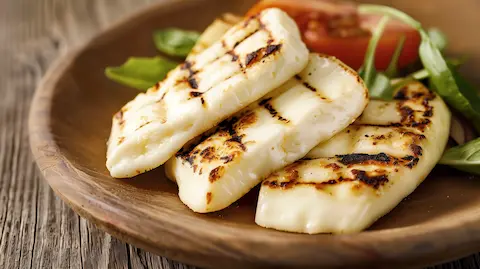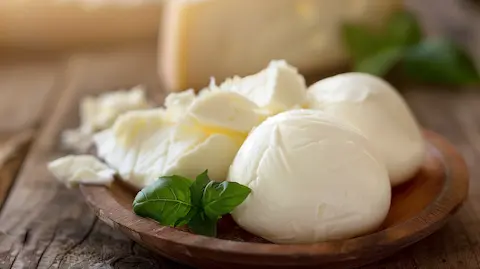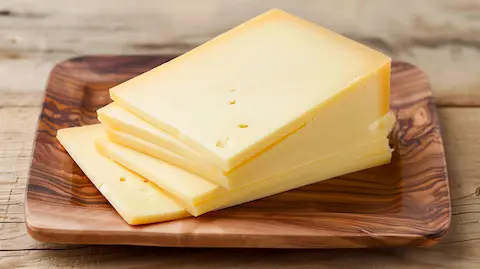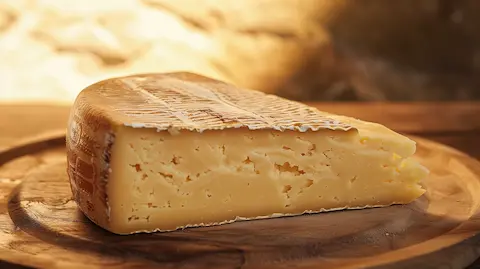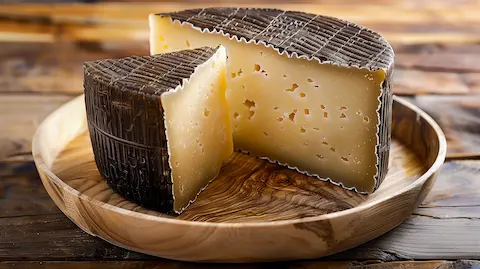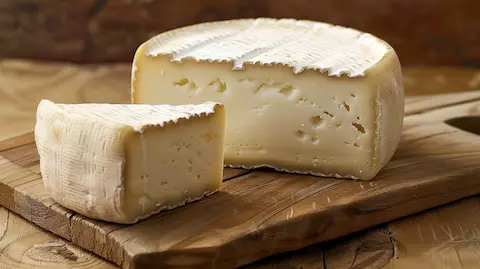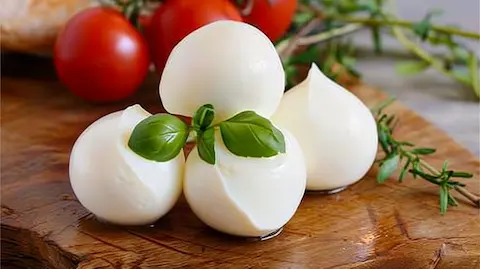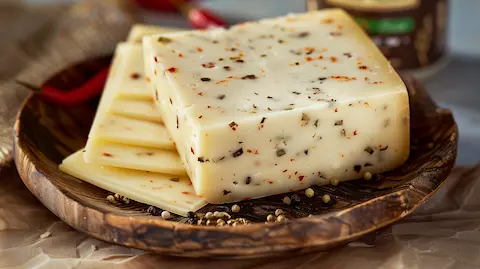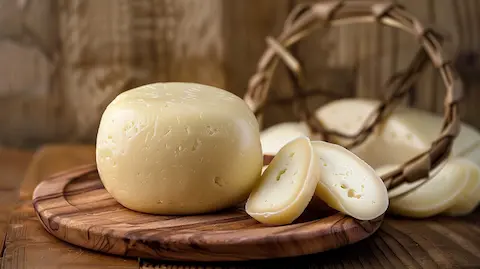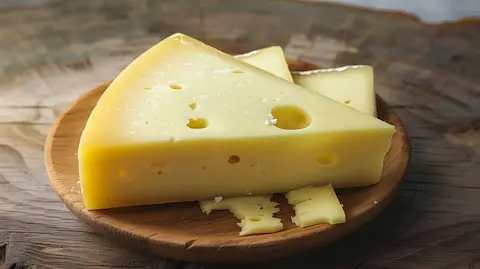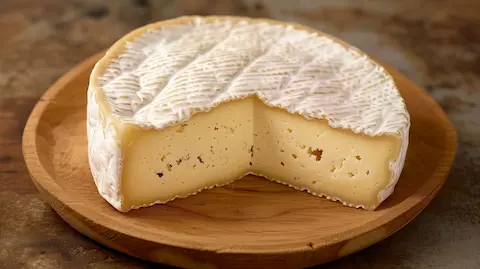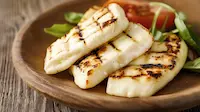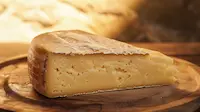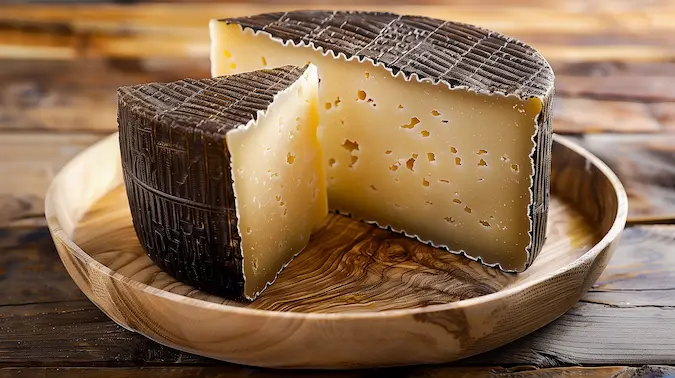Manchego Cheese
Manchego cheese, a symbol of Spanish heritage, comes from the La Mancha region, renowned for its windmills and the legendary Don Quixote. This semi-hard cheese is crafted from the milk of Manchega sheep, a breed native to the area. With a distinctive herringbone rind, Manchego boasts a rich tapestry of flavors, from the sweetness of its creamy heart to the zesty undertones that linger after each bite. The grass mold used in its production imparts a subtle herbaceous aroma, reminiscent of the dry plains of its origin.
As Manchego ages, its texture transforms from smooth to crystalline, offering a sensory journey from the first creamy taste to the final flaky crumble. This cheese is not just a treat for the palate but also a staple of Spanish culture, often enjoyed with a drizzle of honey, a handful of almonds, or a dollop of marmalade. Its role in cuisine is as versatile as its flavor profile, making Manchego a cherished ingredient in kitchens and on cheese boards around the world.
How is Manchego Made?
manchego cheese is made by a meticulous process that begins with the collection of Manchega sheep's milk. The milk is heated and combined with culture and rennet, which coagulates the milk into curds. These curds are then cut, drained, and pressed into molds that imprint the cheese with its characteristic herringbone pattern. The cheese is brined to enhance flavor and preservation before it is aged for a minimum of 60 days. Throughout the aging process, the cheese may be brushed with olive oil, developing its unique flavor and texture.
Manchego Cheese Production Process
| Step | Ingredient | Method | Temperature | Duration |
|---|---|---|---|---|
| Milk Collection | Manchega sheep's milk | Gathering and filtering | Room temperature | Immediate processing |
| Heating | Milk | Heating in vats | 28-32°C (82-90°F) | |
| Coagulation | Culture and rennet | Adding to milk and resting | 30-60 minutes | |
| Curd Processing | Curd | Cutting, stirring, and draining | Varies | |
| Molding | Curd | Pressing into molds | 2-3 hours | |
| Brining | Saltwater | Soaking cheese wheels | 1-2 days | |
| Aging | Maturing in controlled conditions | 10-15°C (50-59°F) | 60 days to 2 years |
What does Manchego taste like?
Manchego tastes like a harmonious blend of rich nuttiness with a tangy, slightly salty undertone. Its complex flavor profile includes notes of caramel and a herbaceous scent, which are a testament to the grasses the Manchega sheep graze on. As Manchego ages, it develops a sharper, more pronounced character with a hint of piquancy, leaving a pleasant, lingering aftertaste reminiscent of the sheep's milk from which it is made.
Manchego Cheese Profile
Exploring profile of Manchego cheese reveals a tapestry of characteristics that contribute to its esteemed status among cheeses. This semi-hard cheese is not only a culinary delight but also a reflection of the region's pastoral traditions.
- Made from: Manchega sheep's milk
- Country of origin: Spain
- Region: La Mancha
- Family: Semi-hard
- Type: Artisan or industrial
- Texture: Ranges from smooth and firm to crystalline with age
- Rind: Inedible, herringbone pattern
- Colour: White to ivory-yellow
- Flavour: Nutty, tangy, with a hint of caramel
- Aroma: Herbaceous, influenced by the grasses of La Mancha
- Vegetarian: No, contains animal rennet
- Producers: Local creameries in La Mancha
- PDO status: Protected Designation of Origin
Origin: Where does Manchego cheese come from?
Manchego cheese comes from the heart of Spain's La Mancha region, a land steeped in pastoral traditions and the art of cheese-making. This storied cheese is the product of an environment perfectly suited for the Manchega sheep, whose milk is the sole ingredient in true Manchego cheese. The region's unique climate and forage impart distinctive qualities to the milk, and thus to the cheese, which cannot be replicated elsewhere. Manchego's identity is deeply rooted in this terroir, making its origin an integral part of its character.
How to Store Manchego?
Proper storage of Manchego ensures its flavors and textures are preserved. In your refrigerator, Manchego should be kept in a slightly humid environment to maintain its moisture. Wrap the cheese in parchment paper followed by a loose layer of plastic wrap to allow it to breathe while preventing it from drying out. This method balances humidity and airflow, which is key to prolonging the cheese's life and quality.
- Wrap: Encase Manchego in parchment paper.
- Cover: Add a layer of plastic wrap for protection.
- Place: Situate in the cheese drawer or a less cold part of the refrigerator.
- Check: Inspect cheese regularly for any signs of spoilage.
- Consume: Enjoy within the optimal time frame for best quality.
How long does Manchego cheese last?
Manchego cheese's shelf life varies depending on storage conditions and its age. When stored properly in the refrigerator, an unopened wheel of Manchego can last between four to six weeks. Once opened, it's best consumed within two weeks, as exposure to air can accelerate spoilage. Freezing Manchego is not recommended, as it can alter the texture and flavor, often resulting in a crumbly consistency and diminished taste upon thawing.
| Manchego Type | Outside | Fridge | Freezer | Texture After Thawing | Taste After Thawing |
|---|---|---|---|---|---|
| Fresco (Fresh) | 2 hours | 1-2 weeks | Not recommended | More crumbly | Possible flavor loss |
| Semicurado (Semi-cured) | 2 hours | 3-4 weeks | |||
| Curado (Cured) | 2 hours | 4-6 weeks | |||
| Viejo (Aged) | 2 hours | 6-8 weeks |
Is Manchego cheese pasteurized?
Manchego cheese can be made from both pasteurized and raw sheep's milk. The choice of milk treatment depends on the cheesemaker's traditions and the desired characteristics of the final product. Pasteurized Manchego is more common in the international market due to strict health regulations, while raw milk versions, known as 'artesano', are highly prized for their depth of flavor and are typically found closer to the production area in Spain.
Can You Freeze Manchego?
No, freezing Manchego is not advisable. While it is possible to freeze this cheese, doing so can significantly alter its texture, leading to a crumbly and less enjoyable consistency. The delicate balance of flavors that Manchego is known for may also be compromised. For those seeking to extend the life of their cheese, proper refrigeration is the preferred method.
How do you know if Manchego cheese has gone bad?
To determine if Manchego cheese has spoiled, look for signs such as an off smell, mold growth beyond the rind, or a sour taste. If you eat moldy Manchego cheese, you may experience digestive discomfort or food poisoning. Therefore, if the cheese shows any signs of spoilage, it is best to discard it to avoid the risk of illness.
Alternatives to Manchego Cheese
While Manchego cheese holds a special place in the hearts of cheese aficionados, there are times when a substitute might be needed. Whether due to availability, dietary preferences, or simply a desire to explore new flavors, knowing alternatives to Manchego can enhance your culinary adventures. The following table presents a curated selection of cheeses that share similarities with Manchego's texture, flavor, or culinary uses, offering a seamless transition for your recipes or cheese boards.
Substitutes for Manchego Cheese
| Cheese | Origin | Milk Source | Texture | Flavor | Aging Time | Why a Good Substitute |
|---|---|---|---|---|---|---|
| Iberico | Spain | Cow, sheep, and goat milk | Semi-hard to hard | Mildly nutty, slightly piquant | 1-2 months | Similar to Manchego but with a more buttery texture due to cow's milk blend. |
| Zamorano | Spain | Sheep's milk | Firm and dense | Nutty, rich, slightly gamey | 6 months | Another Spanish sheep's milk cheese with a comparable flavor profile. |
| Pecorino Romano | Italy | Sheep's milk | Hard | Sharp, salty | 8-12 months | Its bold flavor and hard texture make it a good alternative for aged Manchego. |
| Asiago | Italy | Cow's milk | Semi-soft to hard | Mild, sweet, nutty | 3-12 months | Offers a similar texture range and nuttiness, especially when aged. |
| Monterey Jack | United States | Cow's milk | Semi-soft | Mild, buttery | 1-6 months | Its creamy, mild flavor and melting qualities can mimic young Manchego. |
Manchego Popular Comparison
Manchego is often compared to Pecorino Romano, another sheep's milk cheese. While both have a similar base ingredient, the two cheeses offer distinct experiences in terms of flavor and texture.
Comparing Manchego and Pecorino Romano
| Cheese | Origin | Milk Source | Texture | Flavor | Aging Time | Uses |
|---|---|---|---|---|---|---|
| Manchego | Spain | Sheep's milk | Semi-hard to hard | Rich, nutty, zesty undertones | 60 days to 2 years | Tapas, paired with honey, almonds, or marmalade; not ideal for melting |
| Pecorino Romano | Italy | Sheep's milk | Hard | Sharp, salty | 8-12 months | Grated on pasta, soups, salads; good for melting |
How to Use Manchego
Manchego's robust flavor and firm texture make it a versatile cheese in the kitchen. To cut Manchego, use a sharp knife and slice it into thin wedges from the center outwards, following the natural wedge shape of the wheel. For a younger, softer Manchego, a cheese wire or plane may be more suitable to achieve thin slices without crumbling. This cheese enhances the flavor of various dishes, from simple snacks to complex entrees, and can be enjoyed at any time of day.
| Use | Description |
|---|---|
| Tapas | Serve as part of a tapas spread with olives, cured meats, and crusty bread. |
| Grating | Grate over soups, salads, and pastas for added depth of flavor. |
| Snacking | Enjoy slices with fruit, such as figs or pears, for a quick and satisfying snack. |
| Sandwiches | Include in sandwiches or paninis for a gourmet touch. |
| Melting | Although not ideal for melting due to its texture, small amounts can be melted into sauces for a flavor boost. |
| Pairing | Pair with a glass of Tempranillo or a robust ale to complement its rich flavors. |
How to Serve Manchego Cheese
Serving Manchego cheese is an art that enhances its natural flavors. Present it at room temperature to fully appreciate its complexity. On a cheese board, include a variety of textures and flavors, such as soft goat cheese or a pungent blue, to contrast with Manchego's firmness and nuttiness. Accompany with quince paste, marcona almonds, and a selection of cured meats for a traditional Spanish experience. For wine pairings, consider a fruity Rioja or a crisp Verdejo to balance the cheese's richness.
Recipes Using Manchego
Manchego's unique taste and texture make it an excellent addition to a variety of dishes. Its nutty and tangy flavor enhances the overall profile of recipes, while its firm texture holds up well when sliced, grated, or even melted in moderation. From simple appetizers to hearty main courses, Manchego brings a touch of Spanish flair to any meal.
- Manchego Mac and Cheese: Elevates the classic comfort dish with its rich, complex flavors.
- Stuffed Piquillo Peppers: The sweetness of the peppers complements the nuttiness of Manchego.
- Manchego and Chorizo Pizza: Adds a Spanish twist to pizza with its bold taste.
- Fig and Manchego Salad: The cheese's zestiness contrasts beautifully with the sweetness of figs.
- Manchego Cheese Crisps: Baked until crunchy, they are perfect for snacking or as a garnish.
Manchego Nutrition Data
There are 410 calories in Manchego cheese per 100g. This cheese also provides a significant amount of protein and calcium, making it a nutritious addition to a balanced diet. However, it is high in fat, particularly saturated fat, and should be consumed in moderation, especially by individuals monitoring their fat intake. Manchego is also a source of other essential nutrients such as phosphorus and zinc.
| Nutrient | Amount per 100g | % Daily Value |
|---|---|---|
| Calories | 410 | 20% |
| Total Fat | 34g | 52% |
| Saturated Fat | 19g | 95% |
| Cholesterol | 105mg | 35% |
| Protein | 25g | 50% |
| Calcium | 740mg | 74% |
| Phosphorus | 510mg | 51% |
| Zinc | 2.4mg | 16% |
What's Next? WhatCheese Insights
If you are seeking to purchase Manchego, specialty cheese shops and high-end supermarkets often carry this Spanish delight. For an authentic experience, look for Manchego that has a PDO (Protected Designation of Origin) label, ensuring it comes from the La Mancha region and adheres to stringent production standards. Renowned vineyards in Spain frequently offer cheese tastings, where Manchego is a star, paired with local wines that highlight its rich flavor profile. Keep an eye out for events such as the International Cheese Festival in Spain, where Manchego and other fine cheeses take center stage, offering a fantastic opportunity for enthusiasts to explore and savor.
For those looking to delve deeper into the world of Manchego, consider a visit to La Mancha, where you can witness the cheese-making process firsthand. Many creameries offer tours that allow visitors to see the traditional methods of Manchego production, from the grazing Manchega sheep to the aging cellars. This hands-on approach provides a deeper appreciation for the cheese and its cultural significance. Additionally, engaging with local cheesemongers can provide valuable insights into selecting the best Manchego for your palate.
If you're captivated by the firmness and rich taste of Manchego, you might also enjoy exploring other cheeses within the same category. Aged Cheddar offers a similar crystalline texture with a profound depth of flavor. Gruyère, with its nutty and slightly sweet notes, is another semi-hard cheese that pairs beautifully on a board with Manchego. For those who appreciate the sheep's milk origin, Pecorino Toscano provides a firmer texture with a pleasantly sharp taste that stands up well alongside the milder Manchego. Each of these cheeses provides a unique tasting experience while maintaining the same satisfying firmness that makes Manchego so beloved.

